Financial Management Report: Approaches, Techniques, and Factors
VerifiedAdded on 2023/01/11
|17
|4996
|82
Report
AI Summary
This report delves into financial management, encompassing various approaches, techniques, and factors essential for effective decision-making. It evaluates different decision-making approaches, including autocratic and democratic methods, and highlights techniques like group discussions and financial analysis. The report also examines stakeholder management, emphasizing the importance of addressing conflicting objectives among stakeholder groups. Furthermore, it explores the value of management accounting techniques in cost control, such as marginal analysis, constraint analysis, and capital budgeting, all aimed at maximizing shareholder value. The report also addresses fraud detection and prevention techniques, including statistical parameters, auditing, and internal controls, alongside ethical decision-making considerations. Finally, the report reviews the use of financial statements, investment appraisal techniques, and the role of financial decision-making in ensuring long-term sustainability. The report concludes with recommendations for management accountants.
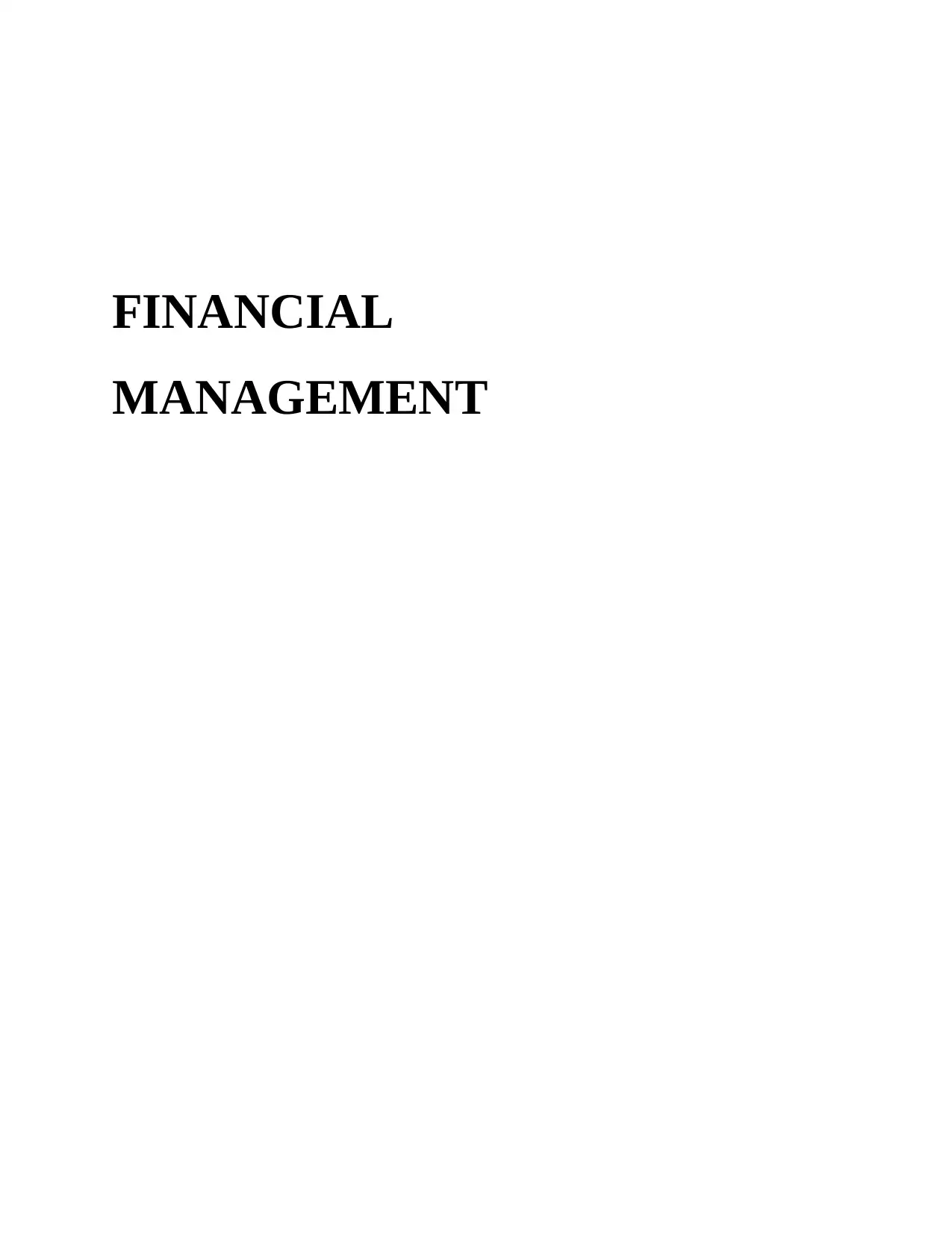
FINANCIAL
MANAGEMENT
MANAGEMENT
Paraphrase This Document
Need a fresh take? Get an instant paraphrase of this document with our AI Paraphraser
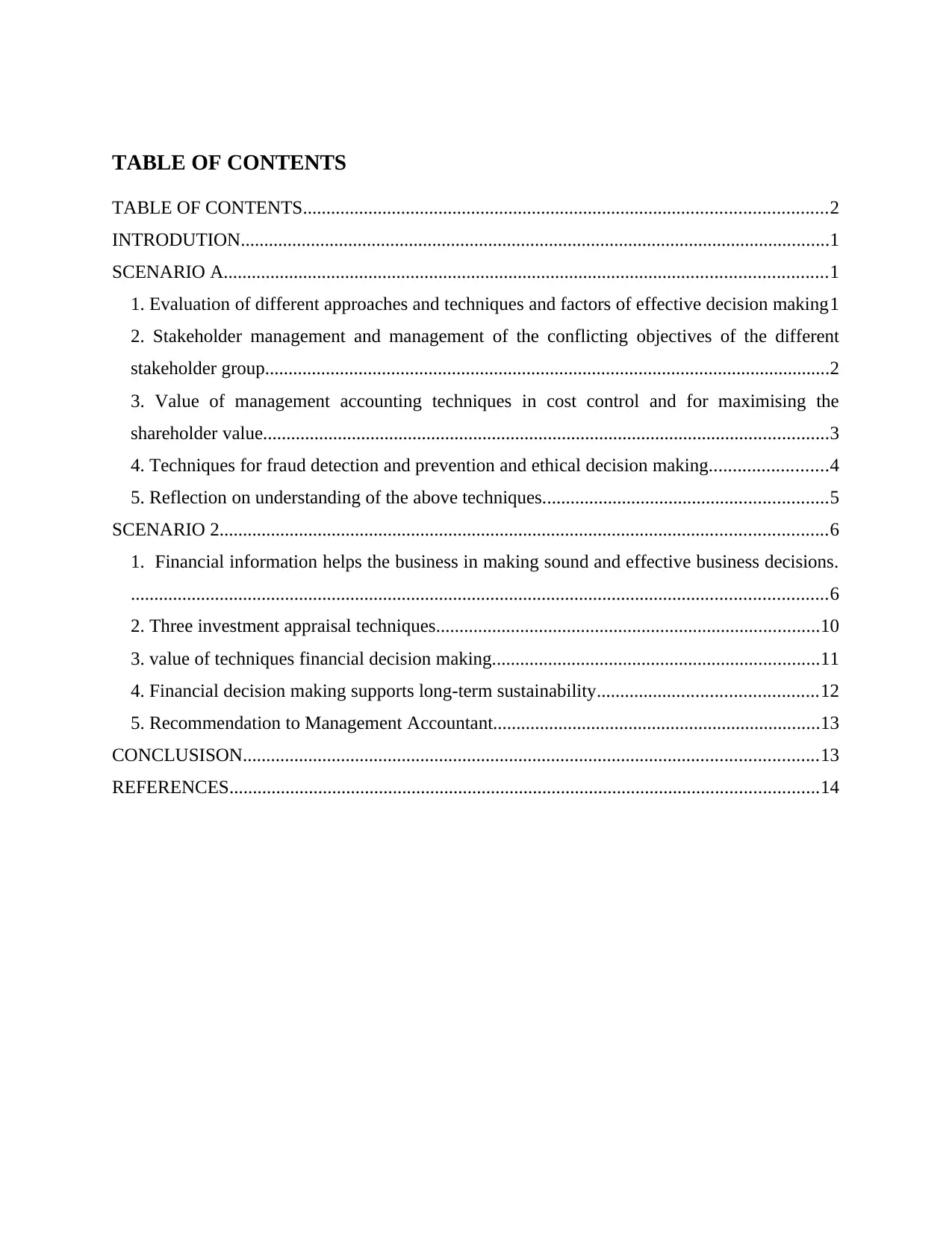
TABLE OF CONTENTS
TABLE OF CONTENTS................................................................................................................2
INTRODUTION..............................................................................................................................1
SCENARIO A.................................................................................................................................1
1. Evaluation of different approaches and techniques and factors of effective decision making1
2. Stakeholder management and management of the conflicting objectives of the different
stakeholder group.........................................................................................................................2
3. Value of management accounting techniques in cost control and for maximising the
shareholder value.........................................................................................................................3
4. Techniques for fraud detection and prevention and ethical decision making.........................4
5. Reflection on understanding of the above techniques.............................................................5
SCENARIO 2..................................................................................................................................6
1. Financial information helps the business in making sound and effective business decisions.
.....................................................................................................................................................6
2. Three investment appraisal techniques..................................................................................10
3. value of techniques financial decision making......................................................................11
4. Financial decision making supports long-term sustainability...............................................12
5. Recommendation to Management Accountant......................................................................13
CONCLUSISON...........................................................................................................................13
REFERENCES..............................................................................................................................14
TABLE OF CONTENTS................................................................................................................2
INTRODUTION..............................................................................................................................1
SCENARIO A.................................................................................................................................1
1. Evaluation of different approaches and techniques and factors of effective decision making1
2. Stakeholder management and management of the conflicting objectives of the different
stakeholder group.........................................................................................................................2
3. Value of management accounting techniques in cost control and for maximising the
shareholder value.........................................................................................................................3
4. Techniques for fraud detection and prevention and ethical decision making.........................4
5. Reflection on understanding of the above techniques.............................................................5
SCENARIO 2..................................................................................................................................6
1. Financial information helps the business in making sound and effective business decisions.
.....................................................................................................................................................6
2. Three investment appraisal techniques..................................................................................10
3. value of techniques financial decision making......................................................................11
4. Financial decision making supports long-term sustainability...............................................12
5. Recommendation to Management Accountant......................................................................13
CONCLUSISON...........................................................................................................................13
REFERENCES..............................................................................................................................14
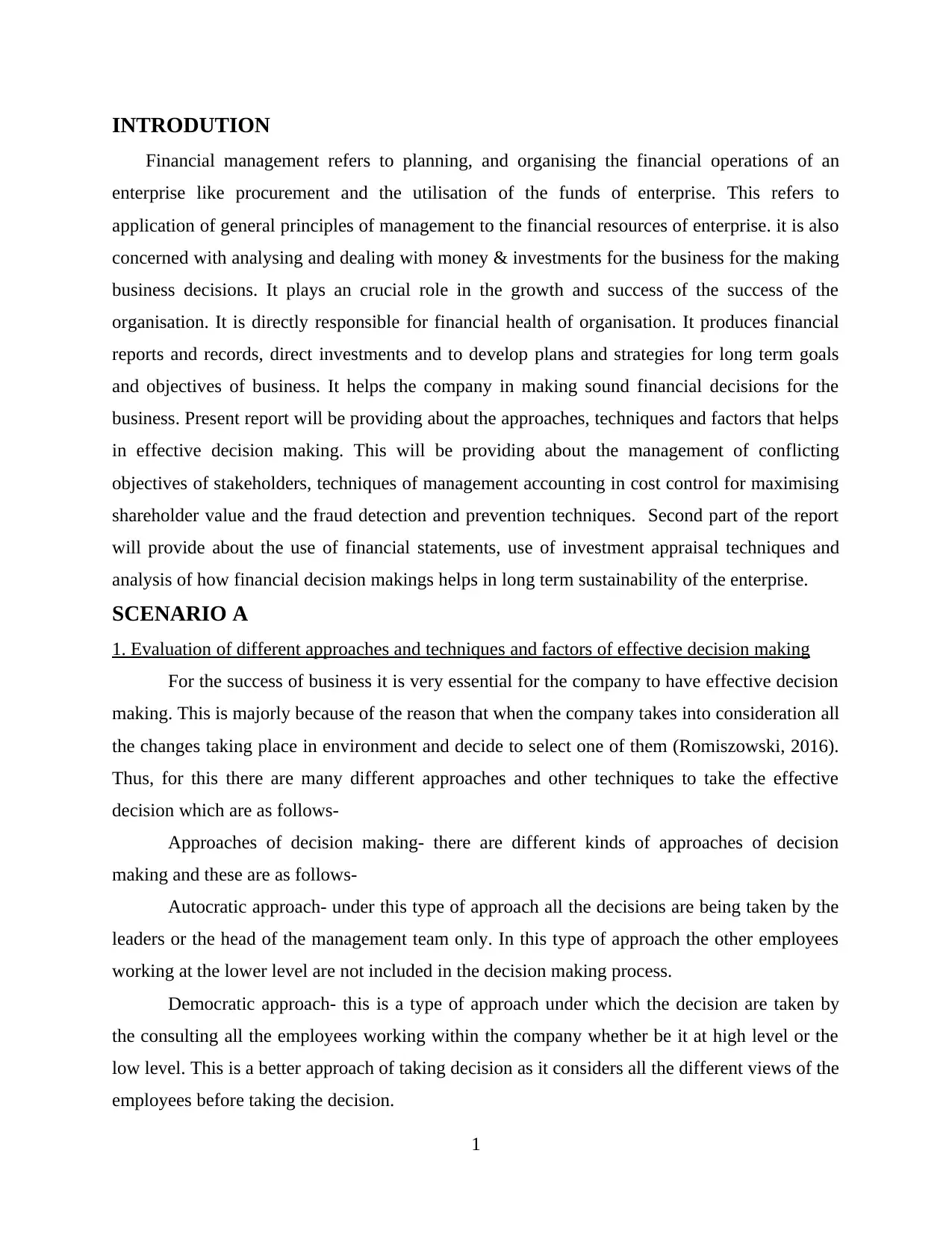
INTRODUTION
Financial management refers to planning, and organising the financial operations of an
enterprise like procurement and the utilisation of the funds of enterprise. This refers to
application of general principles of management to the financial resources of enterprise. it is also
concerned with analysing and dealing with money & investments for the business for the making
business decisions. It plays an crucial role in the growth and success of the success of the
organisation. It is directly responsible for financial health of organisation. It produces financial
reports and records, direct investments and to develop plans and strategies for long term goals
and objectives of business. It helps the company in making sound financial decisions for the
business. Present report will be providing about the approaches, techniques and factors that helps
in effective decision making. This will be providing about the management of conflicting
objectives of stakeholders, techniques of management accounting in cost control for maximising
shareholder value and the fraud detection and prevention techniques. Second part of the report
will provide about the use of financial statements, use of investment appraisal techniques and
analysis of how financial decision makings helps in long term sustainability of the enterprise.
SCENARIO A
1. Evaluation of different approaches and techniques and factors of effective decision making
For the success of business it is very essential for the company to have effective decision
making. This is majorly because of the reason that when the company takes into consideration all
the changes taking place in environment and decide to select one of them (Romiszowski, 2016).
Thus, for this there are many different approaches and other techniques to take the effective
decision which are as follows-
Approaches of decision making- there are different kinds of approaches of decision
making and these are as follows-
Autocratic approach- under this type of approach all the decisions are being taken by the
leaders or the head of the management team only. In this type of approach the other employees
working at the lower level are not included in the decision making process.
Democratic approach- this is a type of approach under which the decision are taken by
the consulting all the employees working within the company whether be it at high level or the
low level. This is a better approach of taking decision as it considers all the different views of the
employees before taking the decision.
1
Financial management refers to planning, and organising the financial operations of an
enterprise like procurement and the utilisation of the funds of enterprise. This refers to
application of general principles of management to the financial resources of enterprise. it is also
concerned with analysing and dealing with money & investments for the business for the making
business decisions. It plays an crucial role in the growth and success of the success of the
organisation. It is directly responsible for financial health of organisation. It produces financial
reports and records, direct investments and to develop plans and strategies for long term goals
and objectives of business. It helps the company in making sound financial decisions for the
business. Present report will be providing about the approaches, techniques and factors that helps
in effective decision making. This will be providing about the management of conflicting
objectives of stakeholders, techniques of management accounting in cost control for maximising
shareholder value and the fraud detection and prevention techniques. Second part of the report
will provide about the use of financial statements, use of investment appraisal techniques and
analysis of how financial decision makings helps in long term sustainability of the enterprise.
SCENARIO A
1. Evaluation of different approaches and techniques and factors of effective decision making
For the success of business it is very essential for the company to have effective decision
making. This is majorly because of the reason that when the company takes into consideration all
the changes taking place in environment and decide to select one of them (Romiszowski, 2016).
Thus, for this there are many different approaches and other techniques to take the effective
decision which are as follows-
Approaches of decision making- there are different kinds of approaches of decision
making and these are as follows-
Autocratic approach- under this type of approach all the decisions are being taken by the
leaders or the head of the management team only. In this type of approach the other employees
working at the lower level are not included in the decision making process.
Democratic approach- this is a type of approach under which the decision are taken by
the consulting all the employees working within the company whether be it at high level or the
low level. This is a better approach of taking decision as it considers all the different views of the
employees before taking the decision.
1
⊘ This is a preview!⊘
Do you want full access?
Subscribe today to unlock all pages.

Trusted by 1+ million students worldwide
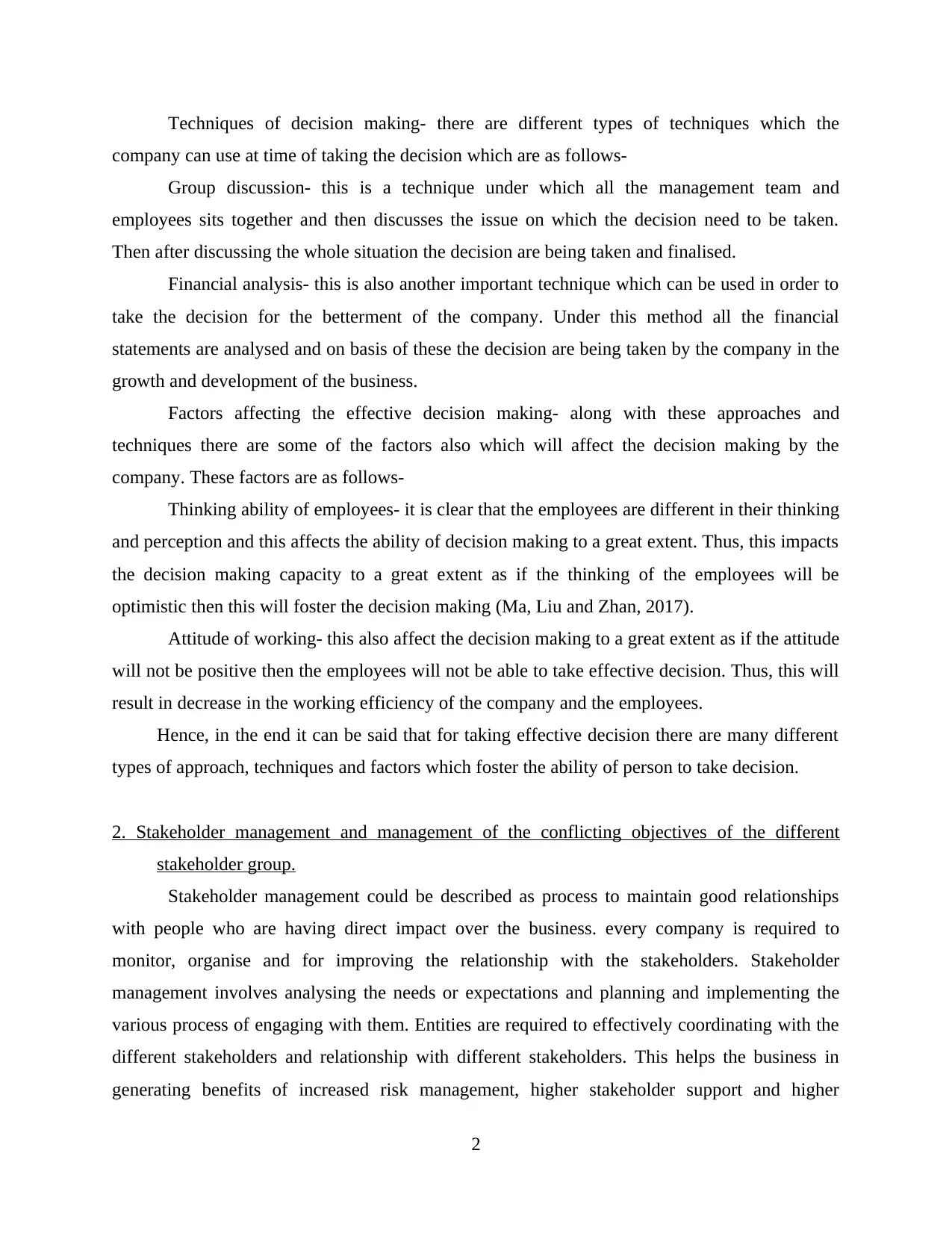
Techniques of decision making- there are different types of techniques which the
company can use at time of taking the decision which are as follows-
Group discussion- this is a technique under which all the management team and
employees sits together and then discusses the issue on which the decision need to be taken.
Then after discussing the whole situation the decision are being taken and finalised.
Financial analysis- this is also another important technique which can be used in order to
take the decision for the betterment of the company. Under this method all the financial
statements are analysed and on basis of these the decision are being taken by the company in the
growth and development of the business.
Factors affecting the effective decision making- along with these approaches and
techniques there are some of the factors also which will affect the decision making by the
company. These factors are as follows-
Thinking ability of employees- it is clear that the employees are different in their thinking
and perception and this affects the ability of decision making to a great extent. Thus, this impacts
the decision making capacity to a great extent as if the thinking of the employees will be
optimistic then this will foster the decision making (Ma, Liu and Zhan, 2017).
Attitude of working- this also affect the decision making to a great extent as if the attitude
will not be positive then the employees will not be able to take effective decision. Thus, this will
result in decrease in the working efficiency of the company and the employees.
Hence, in the end it can be said that for taking effective decision there are many different
types of approach, techniques and factors which foster the ability of person to take decision.
2. Stakeholder management and management of the conflicting objectives of the different
stakeholder group.
Stakeholder management could be described as process to maintain good relationships
with people who are having direct impact over the business. every company is required to
monitor, organise and for improving the relationship with the stakeholders. Stakeholder
management involves analysing the needs or expectations and planning and implementing the
various process of engaging with them. Entities are required to effectively coordinating with the
different stakeholders and relationship with different stakeholders. This helps the business in
generating benefits of increased risk management, higher stakeholder support and higher
2
company can use at time of taking the decision which are as follows-
Group discussion- this is a technique under which all the management team and
employees sits together and then discusses the issue on which the decision need to be taken.
Then after discussing the whole situation the decision are being taken and finalised.
Financial analysis- this is also another important technique which can be used in order to
take the decision for the betterment of the company. Under this method all the financial
statements are analysed and on basis of these the decision are being taken by the company in the
growth and development of the business.
Factors affecting the effective decision making- along with these approaches and
techniques there are some of the factors also which will affect the decision making by the
company. These factors are as follows-
Thinking ability of employees- it is clear that the employees are different in their thinking
and perception and this affects the ability of decision making to a great extent. Thus, this impacts
the decision making capacity to a great extent as if the thinking of the employees will be
optimistic then this will foster the decision making (Ma, Liu and Zhan, 2017).
Attitude of working- this also affect the decision making to a great extent as if the attitude
will not be positive then the employees will not be able to take effective decision. Thus, this will
result in decrease in the working efficiency of the company and the employees.
Hence, in the end it can be said that for taking effective decision there are many different
types of approach, techniques and factors which foster the ability of person to take decision.
2. Stakeholder management and management of the conflicting objectives of the different
stakeholder group.
Stakeholder management could be described as process to maintain good relationships
with people who are having direct impact over the business. every company is required to
monitor, organise and for improving the relationship with the stakeholders. Stakeholder
management involves analysing the needs or expectations and planning and implementing the
various process of engaging with them. Entities are required to effectively coordinating with the
different stakeholders and relationship with different stakeholders. This helps the business in
generating benefits of increased risk management, higher stakeholder support and higher
2
Paraphrase This Document
Need a fresh take? Get an instant paraphrase of this document with our AI Paraphraser
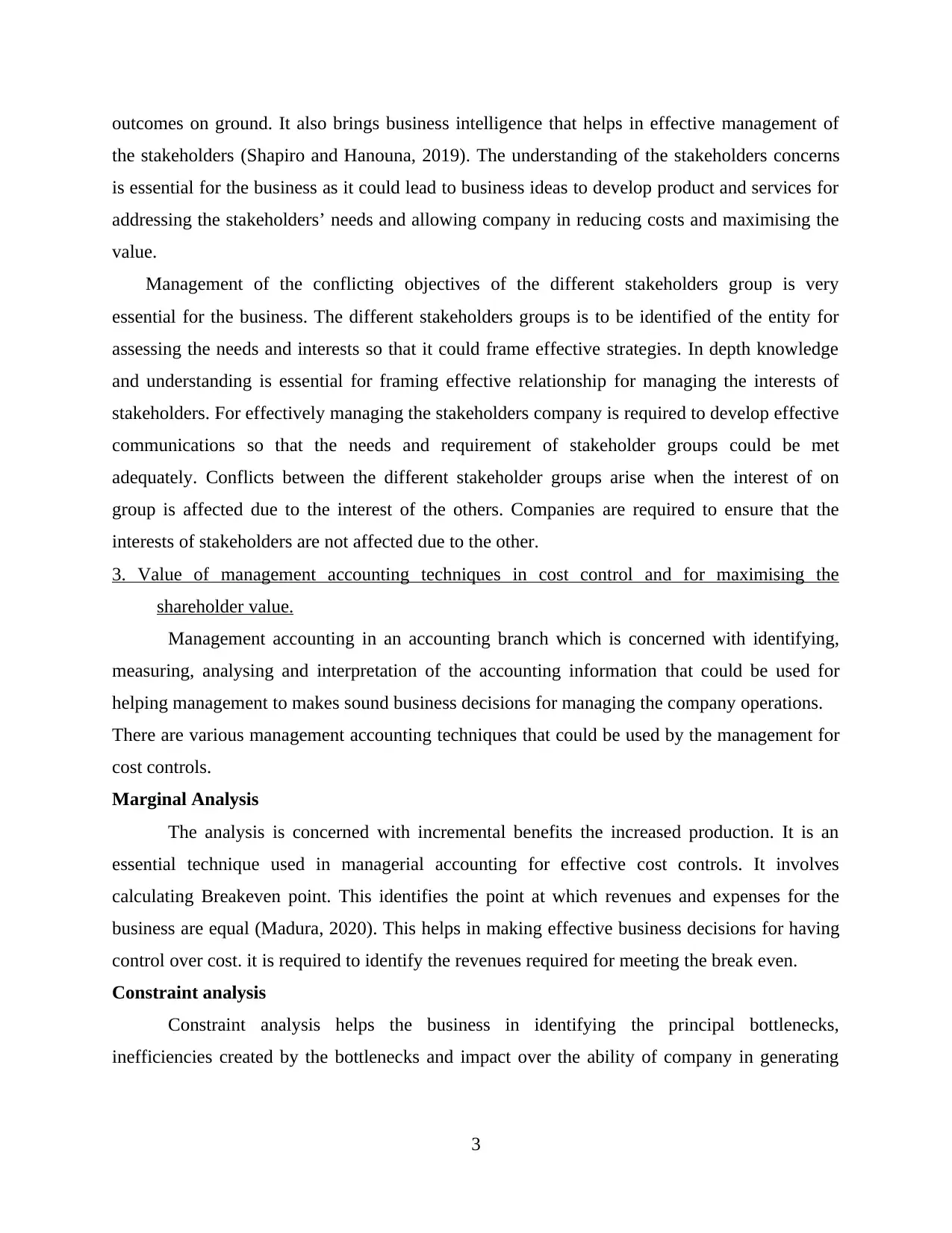
outcomes on ground. It also brings business intelligence that helps in effective management of
the stakeholders (Shapiro and Hanouna, 2019). The understanding of the stakeholders concerns
is essential for the business as it could lead to business ideas to develop product and services for
addressing the stakeholders’ needs and allowing company in reducing costs and maximising the
value.
Management of the conflicting objectives of the different stakeholders group is very
essential for the business. The different stakeholders groups is to be identified of the entity for
assessing the needs and interests so that it could frame effective strategies. In depth knowledge
and understanding is essential for framing effective relationship for managing the interests of
stakeholders. For effectively managing the stakeholders company is required to develop effective
communications so that the needs and requirement of stakeholder groups could be met
adequately. Conflicts between the different stakeholder groups arise when the interest of on
group is affected due to the interest of the others. Companies are required to ensure that the
interests of stakeholders are not affected due to the other.
3. Value of management accounting techniques in cost control and for maximising the
shareholder value.
Management accounting in an accounting branch which is concerned with identifying,
measuring, analysing and interpretation of the accounting information that could be used for
helping management to makes sound business decisions for managing the company operations.
There are various management accounting techniques that could be used by the management for
cost controls.
Marginal Analysis
The analysis is concerned with incremental benefits the increased production. It is an
essential technique used in managerial accounting for effective cost controls. It involves
calculating Breakeven point. This identifies the point at which revenues and expenses for the
business are equal (Madura, 2020). This helps in making effective business decisions for having
control over cost. it is required to identify the revenues required for meeting the break even.
Constraint analysis
Constraint analysis helps the business in identifying the principal bottlenecks,
inefficiencies created by the bottlenecks and impact over the ability of company in generating
3
the stakeholders (Shapiro and Hanouna, 2019). The understanding of the stakeholders concerns
is essential for the business as it could lead to business ideas to develop product and services for
addressing the stakeholders’ needs and allowing company in reducing costs and maximising the
value.
Management of the conflicting objectives of the different stakeholders group is very
essential for the business. The different stakeholders groups is to be identified of the entity for
assessing the needs and interests so that it could frame effective strategies. In depth knowledge
and understanding is essential for framing effective relationship for managing the interests of
stakeholders. For effectively managing the stakeholders company is required to develop effective
communications so that the needs and requirement of stakeholder groups could be met
adequately. Conflicts between the different stakeholder groups arise when the interest of on
group is affected due to the interest of the others. Companies are required to ensure that the
interests of stakeholders are not affected due to the other.
3. Value of management accounting techniques in cost control and for maximising the
shareholder value.
Management accounting in an accounting branch which is concerned with identifying,
measuring, analysing and interpretation of the accounting information that could be used for
helping management to makes sound business decisions for managing the company operations.
There are various management accounting techniques that could be used by the management for
cost controls.
Marginal Analysis
The analysis is concerned with incremental benefits the increased production. It is an
essential technique used in managerial accounting for effective cost controls. It involves
calculating Breakeven point. This identifies the point at which revenues and expenses for the
business are equal (Madura, 2020). This helps in making effective business decisions for having
control over cost. it is required to identify the revenues required for meeting the break even.
Constraint analysis
Constraint analysis helps the business in identifying the principal bottlenecks,
inefficiencies created by the bottlenecks and impact over the ability of company in generating
3
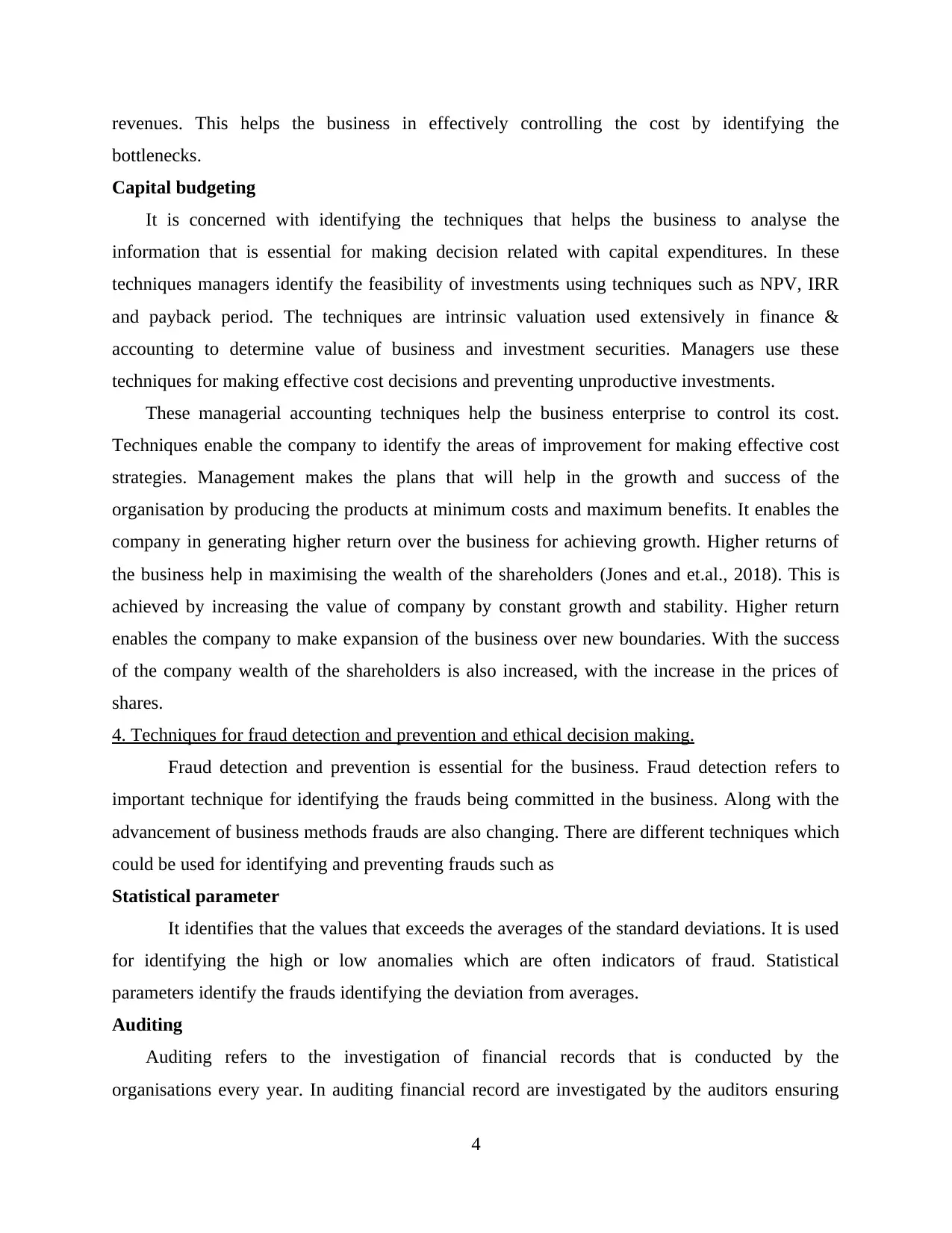
revenues. This helps the business in effectively controlling the cost by identifying the
bottlenecks.
Capital budgeting
It is concerned with identifying the techniques that helps the business to analyse the
information that is essential for making decision related with capital expenditures. In these
techniques managers identify the feasibility of investments using techniques such as NPV, IRR
and payback period. The techniques are intrinsic valuation used extensively in finance &
accounting to determine value of business and investment securities. Managers use these
techniques for making effective cost decisions and preventing unproductive investments.
These managerial accounting techniques help the business enterprise to control its cost.
Techniques enable the company to identify the areas of improvement for making effective cost
strategies. Management makes the plans that will help in the growth and success of the
organisation by producing the products at minimum costs and maximum benefits. It enables the
company in generating higher return over the business for achieving growth. Higher returns of
the business help in maximising the wealth of the shareholders (Jones and et.al., 2018). This is
achieved by increasing the value of company by constant growth and stability. Higher return
enables the company to make expansion of the business over new boundaries. With the success
of the company wealth of the shareholders is also increased, with the increase in the prices of
shares.
4. Techniques for fraud detection and prevention and ethical decision making.
Fraud detection and prevention is essential for the business. Fraud detection refers to
important technique for identifying the frauds being committed in the business. Along with the
advancement of business methods frauds are also changing. There are different techniques which
could be used for identifying and preventing frauds such as
Statistical parameter
It identifies that the values that exceeds the averages of the standard deviations. It is used
for identifying the high or low anomalies which are often indicators of fraud. Statistical
parameters identify the frauds identifying the deviation from averages.
Auditing
Auditing refers to the investigation of financial records that is conducted by the
organisations every year. In auditing financial record are investigated by the auditors ensuring
4
bottlenecks.
Capital budgeting
It is concerned with identifying the techniques that helps the business to analyse the
information that is essential for making decision related with capital expenditures. In these
techniques managers identify the feasibility of investments using techniques such as NPV, IRR
and payback period. The techniques are intrinsic valuation used extensively in finance &
accounting to determine value of business and investment securities. Managers use these
techniques for making effective cost decisions and preventing unproductive investments.
These managerial accounting techniques help the business enterprise to control its cost.
Techniques enable the company to identify the areas of improvement for making effective cost
strategies. Management makes the plans that will help in the growth and success of the
organisation by producing the products at minimum costs and maximum benefits. It enables the
company in generating higher return over the business for achieving growth. Higher returns of
the business help in maximising the wealth of the shareholders (Jones and et.al., 2018). This is
achieved by increasing the value of company by constant growth and stability. Higher return
enables the company to make expansion of the business over new boundaries. With the success
of the company wealth of the shareholders is also increased, with the increase in the prices of
shares.
4. Techniques for fraud detection and prevention and ethical decision making.
Fraud detection and prevention is essential for the business. Fraud detection refers to
important technique for identifying the frauds being committed in the business. Along with the
advancement of business methods frauds are also changing. There are different techniques which
could be used for identifying and preventing frauds such as
Statistical parameter
It identifies that the values that exceeds the averages of the standard deviations. It is used
for identifying the high or low anomalies which are often indicators of fraud. Statistical
parameters identify the frauds identifying the deviation from averages.
Auditing
Auditing refers to the investigation of financial records that is conducted by the
organisations every year. In auditing financial record are investigated by the auditors ensuring
4
⊘ This is a preview!⊘
Do you want full access?
Subscribe today to unlock all pages.

Trusted by 1+ million students worldwide
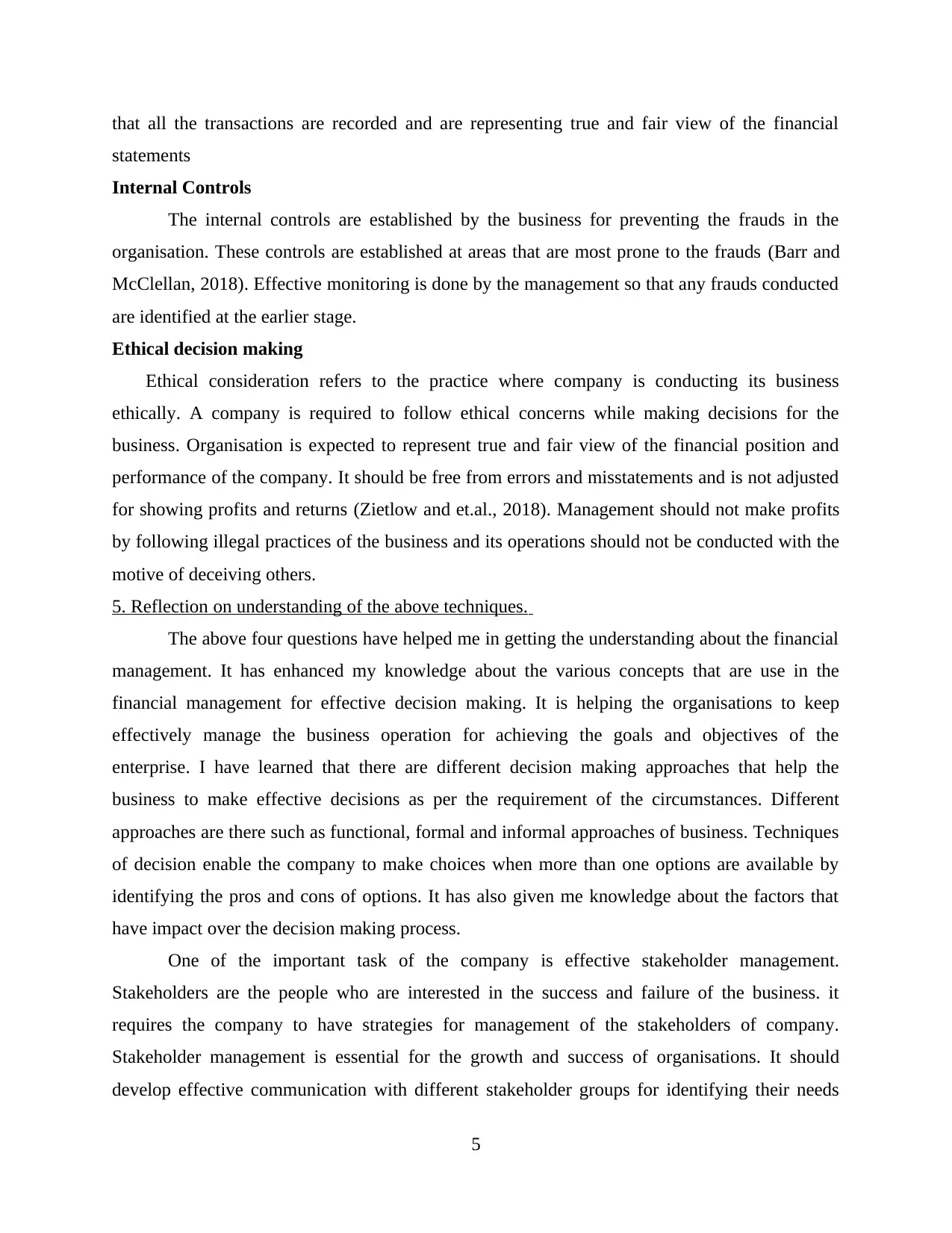
that all the transactions are recorded and are representing true and fair view of the financial
statements
Internal Controls
The internal controls are established by the business for preventing the frauds in the
organisation. These controls are established at areas that are most prone to the frauds (Barr and
McClellan, 2018). Effective monitoring is done by the management so that any frauds conducted
are identified at the earlier stage.
Ethical decision making
Ethical consideration refers to the practice where company is conducting its business
ethically. A company is required to follow ethical concerns while making decisions for the
business. Organisation is expected to represent true and fair view of the financial position and
performance of the company. It should be free from errors and misstatements and is not adjusted
for showing profits and returns (Zietlow and et.al., 2018). Management should not make profits
by following illegal practices of the business and its operations should not be conducted with the
motive of deceiving others.
5. Reflection on understanding of the above techniques.
The above four questions have helped me in getting the understanding about the financial
management. It has enhanced my knowledge about the various concepts that are use in the
financial management for effective decision making. It is helping the organisations to keep
effectively manage the business operation for achieving the goals and objectives of the
enterprise. I have learned that there are different decision making approaches that help the
business to make effective decisions as per the requirement of the circumstances. Different
approaches are there such as functional, formal and informal approaches of business. Techniques
of decision enable the company to make choices when more than one options are available by
identifying the pros and cons of options. It has also given me knowledge about the factors that
have impact over the decision making process.
One of the important task of the company is effective stakeholder management.
Stakeholders are the people who are interested in the success and failure of the business. it
requires the company to have strategies for management of the stakeholders of company.
Stakeholder management is essential for the growth and success of organisations. It should
develop effective communication with different stakeholder groups for identifying their needs
5
statements
Internal Controls
The internal controls are established by the business for preventing the frauds in the
organisation. These controls are established at areas that are most prone to the frauds (Barr and
McClellan, 2018). Effective monitoring is done by the management so that any frauds conducted
are identified at the earlier stage.
Ethical decision making
Ethical consideration refers to the practice where company is conducting its business
ethically. A company is required to follow ethical concerns while making decisions for the
business. Organisation is expected to represent true and fair view of the financial position and
performance of the company. It should be free from errors and misstatements and is not adjusted
for showing profits and returns (Zietlow and et.al., 2018). Management should not make profits
by following illegal practices of the business and its operations should not be conducted with the
motive of deceiving others.
5. Reflection on understanding of the above techniques.
The above four questions have helped me in getting the understanding about the financial
management. It has enhanced my knowledge about the various concepts that are use in the
financial management for effective decision making. It is helping the organisations to keep
effectively manage the business operation for achieving the goals and objectives of the
enterprise. I have learned that there are different decision making approaches that help the
business to make effective decisions as per the requirement of the circumstances. Different
approaches are there such as functional, formal and informal approaches of business. Techniques
of decision enable the company to make choices when more than one options are available by
identifying the pros and cons of options. It has also given me knowledge about the factors that
have impact over the decision making process.
One of the important task of the company is effective stakeholder management.
Stakeholders are the people who are interested in the success and failure of the business. it
requires the company to have strategies for management of the stakeholders of company.
Stakeholder management is essential for the growth and success of organisations. It should
develop effective communication with different stakeholder groups for identifying their needs
5
Paraphrase This Document
Need a fresh take? Get an instant paraphrase of this document with our AI Paraphraser
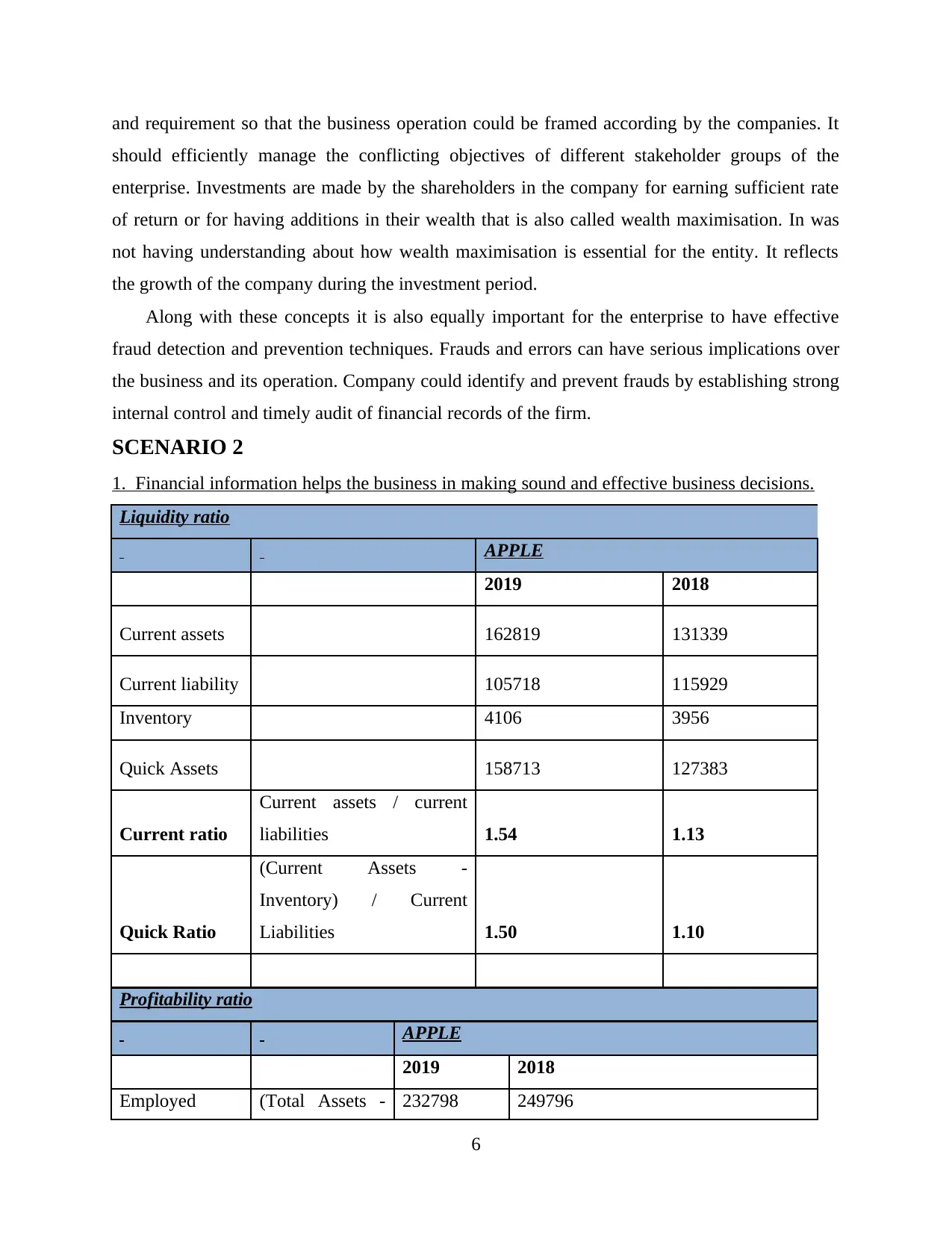
and requirement so that the business operation could be framed according by the companies. It
should efficiently manage the conflicting objectives of different stakeholder groups of the
enterprise. Investments are made by the shareholders in the company for earning sufficient rate
of return or for having additions in their wealth that is also called wealth maximisation. In was
not having understanding about how wealth maximisation is essential for the entity. It reflects
the growth of the company during the investment period.
Along with these concepts it is also equally important for the enterprise to have effective
fraud detection and prevention techniques. Frauds and errors can have serious implications over
the business and its operation. Company could identify and prevent frauds by establishing strong
internal control and timely audit of financial records of the firm.
SCENARIO 2
1. Financial information helps the business in making sound and effective business decisions.
Liquidity ratio
APPLE
2019 2018
Current assets 162819 131339
Current liability 105718 115929
Inventory 4106 3956
Quick Assets 158713 127383
Current ratio
Current assets / current
liabilities 1.54 1.13
Quick Ratio
(Current Assets -
Inventory) / Current
Liabilities 1.50 1.10
Profitability ratio
APPLE
2019 2018
Employed (Total Assets - 232798 249796
6
should efficiently manage the conflicting objectives of different stakeholder groups of the
enterprise. Investments are made by the shareholders in the company for earning sufficient rate
of return or for having additions in their wealth that is also called wealth maximisation. In was
not having understanding about how wealth maximisation is essential for the entity. It reflects
the growth of the company during the investment period.
Along with these concepts it is also equally important for the enterprise to have effective
fraud detection and prevention techniques. Frauds and errors can have serious implications over
the business and its operation. Company could identify and prevent frauds by establishing strong
internal control and timely audit of financial records of the firm.
SCENARIO 2
1. Financial information helps the business in making sound and effective business decisions.
Liquidity ratio
APPLE
2019 2018
Current assets 162819 131339
Current liability 105718 115929
Inventory 4106 3956
Quick Assets 158713 127383
Current ratio
Current assets / current
liabilities 1.54 1.13
Quick Ratio
(Current Assets -
Inventory) / Current
Liabilities 1.50 1.10
Profitability ratio
APPLE
2019 2018
Employed (Total Assets - 232798 249796
6
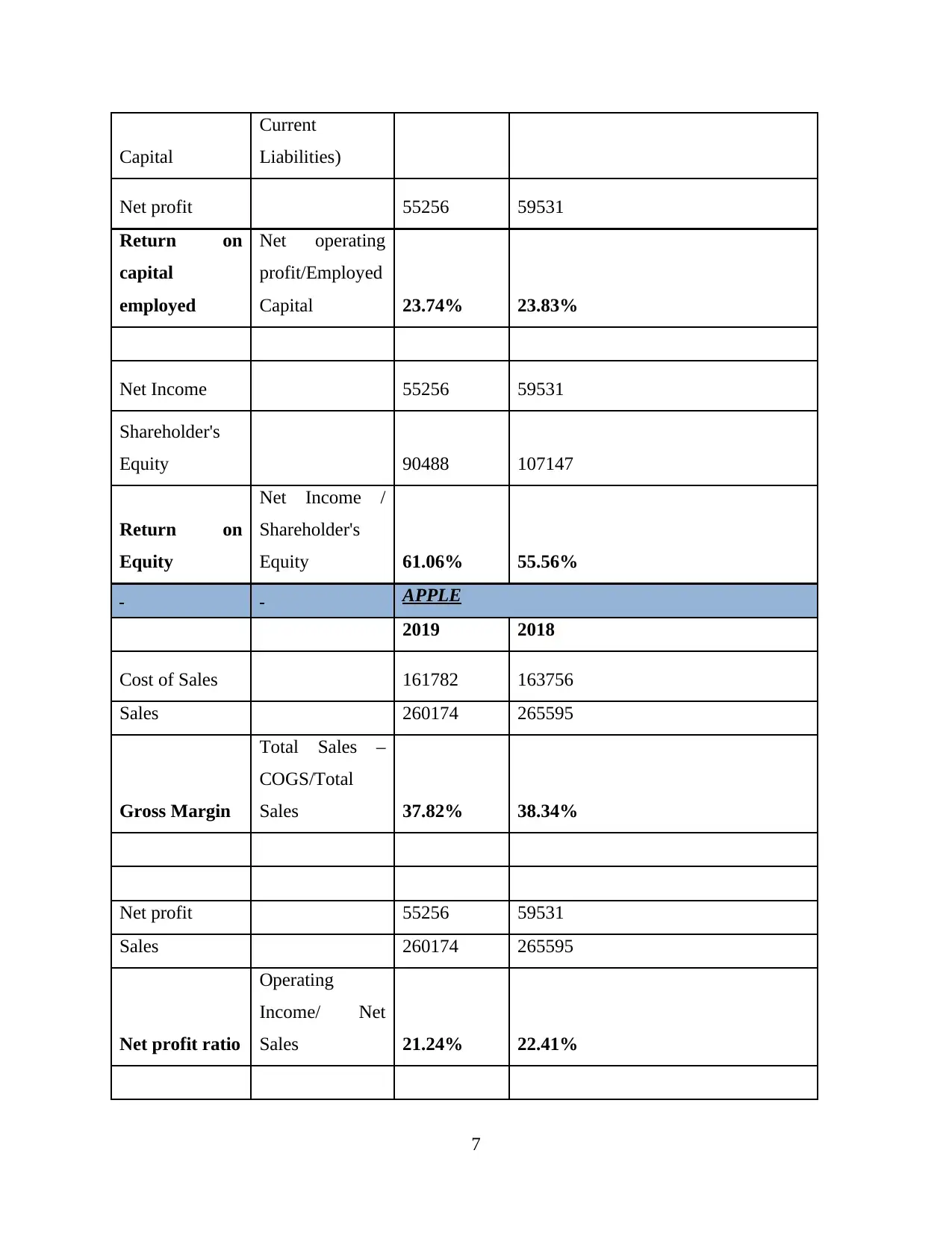
Capital
Current
Liabilities)
Net profit 55256 59531
Return on
capital
employed
Net operating
profit/Employed
Capital 23.74% 23.83%
Net Income 55256 59531
Shareholder's
Equity 90488 107147
Return on
Equity
Net Income /
Shareholder's
Equity 61.06% 55.56%
APPLE
2019 2018
Cost of Sales 161782 163756
Sales 260174 265595
Gross Margin
Total Sales –
COGS/Total
Sales 37.82% 38.34%
Net profit 55256 59531
Sales 260174 265595
Net profit ratio
Operating
Income/ Net
Sales 21.24% 22.41%
7
Current
Liabilities)
Net profit 55256 59531
Return on
capital
employed
Net operating
profit/Employed
Capital 23.74% 23.83%
Net Income 55256 59531
Shareholder's
Equity 90488 107147
Return on
Equity
Net Income /
Shareholder's
Equity 61.06% 55.56%
APPLE
2019 2018
Cost of Sales 161782 163756
Sales 260174 265595
Gross Margin
Total Sales –
COGS/Total
Sales 37.82% 38.34%
Net profit 55256 59531
Sales 260174 265595
Net profit ratio
Operating
Income/ Net
Sales 21.24% 22.41%
7
⊘ This is a preview!⊘
Do you want full access?
Subscribe today to unlock all pages.

Trusted by 1+ million students worldwide
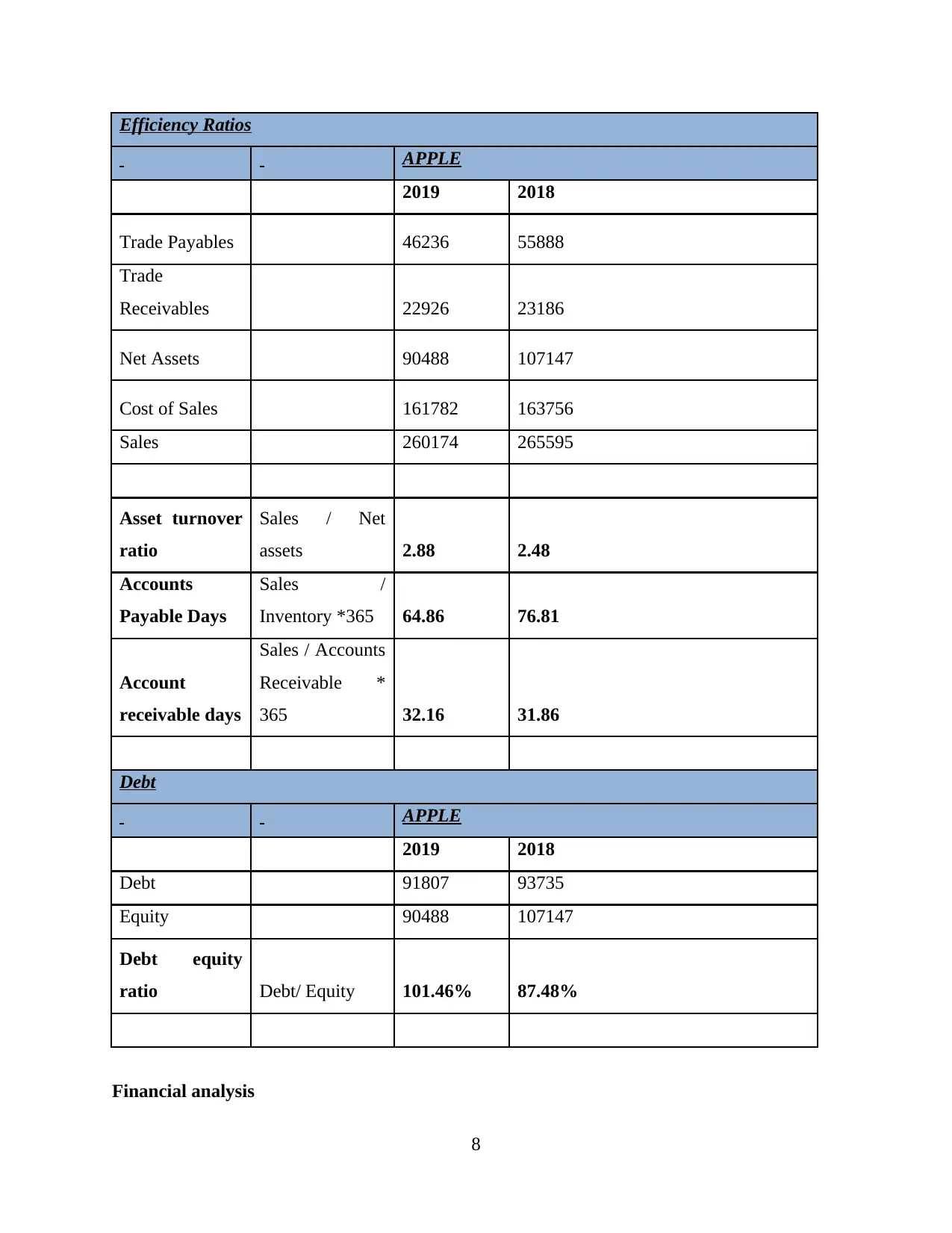
Efficiency Ratios
APPLE
2019 2018
Trade Payables 46236 55888
Trade
Receivables 22926 23186
Net Assets 90488 107147
Cost of Sales 161782 163756
Sales 260174 265595
Asset turnover
ratio
Sales / Net
assets 2.88 2.48
Accounts
Payable Days
Sales /
Inventory *365 64.86 76.81
Account
receivable days
Sales / Accounts
Receivable *
365 32.16 31.86
Debt
APPLE
2019 2018
Debt 91807 93735
Equity 90488 107147
Debt equity
ratio Debt/ Equity 101.46% 87.48%
Financial analysis
8
APPLE
2019 2018
Trade Payables 46236 55888
Trade
Receivables 22926 23186
Net Assets 90488 107147
Cost of Sales 161782 163756
Sales 260174 265595
Asset turnover
ratio
Sales / Net
assets 2.88 2.48
Accounts
Payable Days
Sales /
Inventory *365 64.86 76.81
Account
receivable days
Sales / Accounts
Receivable *
365 32.16 31.86
Debt
APPLE
2019 2018
Debt 91807 93735
Equity 90488 107147
Debt equity
ratio Debt/ Equity 101.46% 87.48%
Financial analysis
8
Paraphrase This Document
Need a fresh take? Get an instant paraphrase of this document with our AI Paraphraser
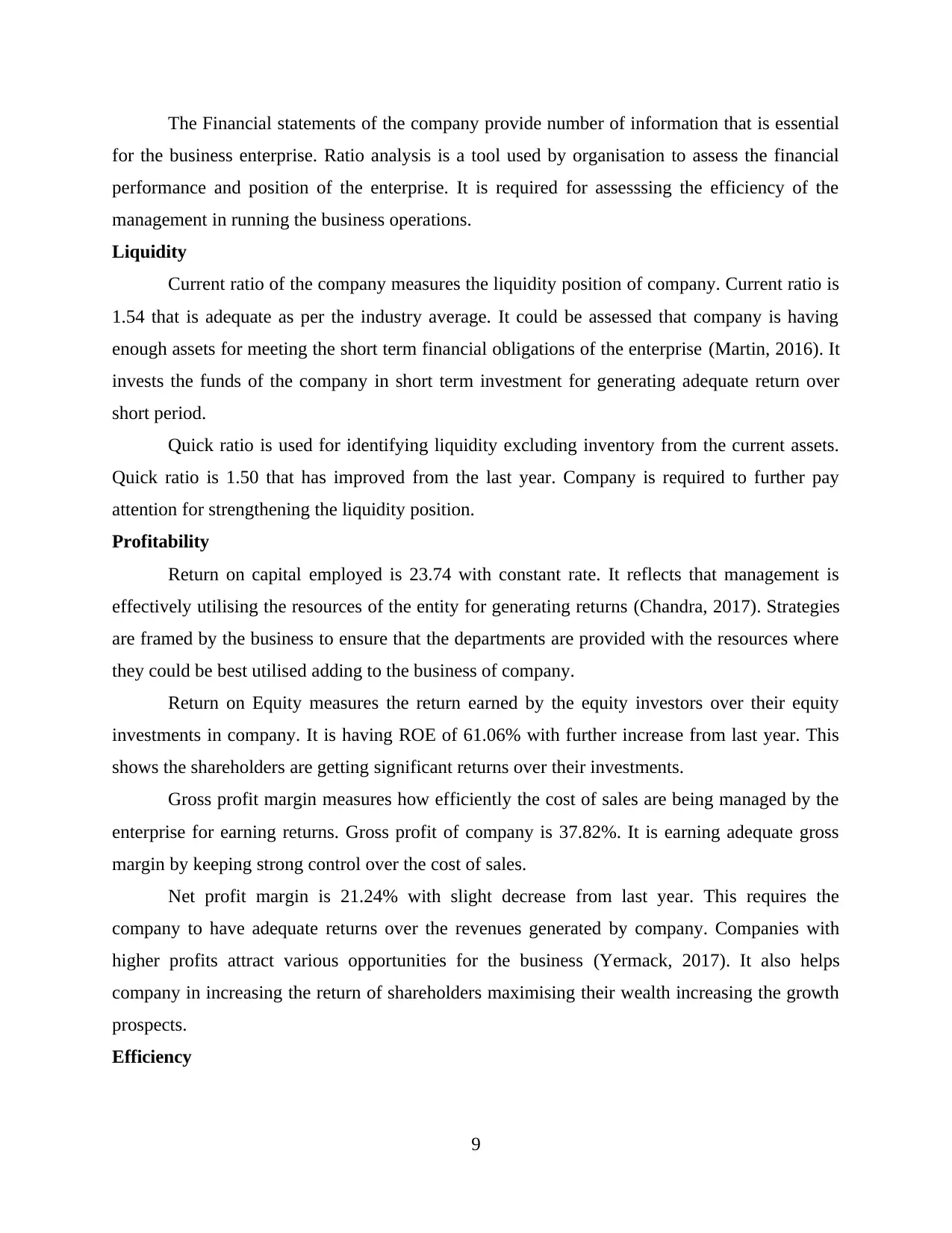
The Financial statements of the company provide number of information that is essential
for the business enterprise. Ratio analysis is a tool used by organisation to assess the financial
performance and position of the enterprise. It is required for assesssing the efficiency of the
management in running the business operations.
Liquidity
Current ratio of the company measures the liquidity position of company. Current ratio is
1.54 that is adequate as per the industry average. It could be assessed that company is having
enough assets for meeting the short term financial obligations of the enterprise (Martin, 2016). It
invests the funds of the company in short term investment for generating adequate return over
short period.
Quick ratio is used for identifying liquidity excluding inventory from the current assets.
Quick ratio is 1.50 that has improved from the last year. Company is required to further pay
attention for strengthening the liquidity position.
Profitability
Return on capital employed is 23.74 with constant rate. It reflects that management is
effectively utilising the resources of the entity for generating returns (Chandra, 2017). Strategies
are framed by the business to ensure that the departments are provided with the resources where
they could be best utilised adding to the business of company.
Return on Equity measures the return earned by the equity investors over their equity
investments in company. It is having ROE of 61.06% with further increase from last year. This
shows the shareholders are getting significant returns over their investments.
Gross profit margin measures how efficiently the cost of sales are being managed by the
enterprise for earning returns. Gross profit of company is 37.82%. It is earning adequate gross
margin by keeping strong control over the cost of sales.
Net profit margin is 21.24% with slight decrease from last year. This requires the
company to have adequate returns over the revenues generated by company. Companies with
higher profits attract various opportunities for the business (Yermack, 2017). It also helps
company in increasing the return of shareholders maximising their wealth increasing the growth
prospects.
Efficiency
9
for the business enterprise. Ratio analysis is a tool used by organisation to assess the financial
performance and position of the enterprise. It is required for assesssing the efficiency of the
management in running the business operations.
Liquidity
Current ratio of the company measures the liquidity position of company. Current ratio is
1.54 that is adequate as per the industry average. It could be assessed that company is having
enough assets for meeting the short term financial obligations of the enterprise (Martin, 2016). It
invests the funds of the company in short term investment for generating adequate return over
short period.
Quick ratio is used for identifying liquidity excluding inventory from the current assets.
Quick ratio is 1.50 that has improved from the last year. Company is required to further pay
attention for strengthening the liquidity position.
Profitability
Return on capital employed is 23.74 with constant rate. It reflects that management is
effectively utilising the resources of the entity for generating returns (Chandra, 2017). Strategies
are framed by the business to ensure that the departments are provided with the resources where
they could be best utilised adding to the business of company.
Return on Equity measures the return earned by the equity investors over their equity
investments in company. It is having ROE of 61.06% with further increase from last year. This
shows the shareholders are getting significant returns over their investments.
Gross profit margin measures how efficiently the cost of sales are being managed by the
enterprise for earning returns. Gross profit of company is 37.82%. It is earning adequate gross
margin by keeping strong control over the cost of sales.
Net profit margin is 21.24% with slight decrease from last year. This requires the
company to have adequate returns over the revenues generated by company. Companies with
higher profits attract various opportunities for the business (Yermack, 2017). It also helps
company in increasing the return of shareholders maximising their wealth increasing the growth
prospects.
Efficiency
9
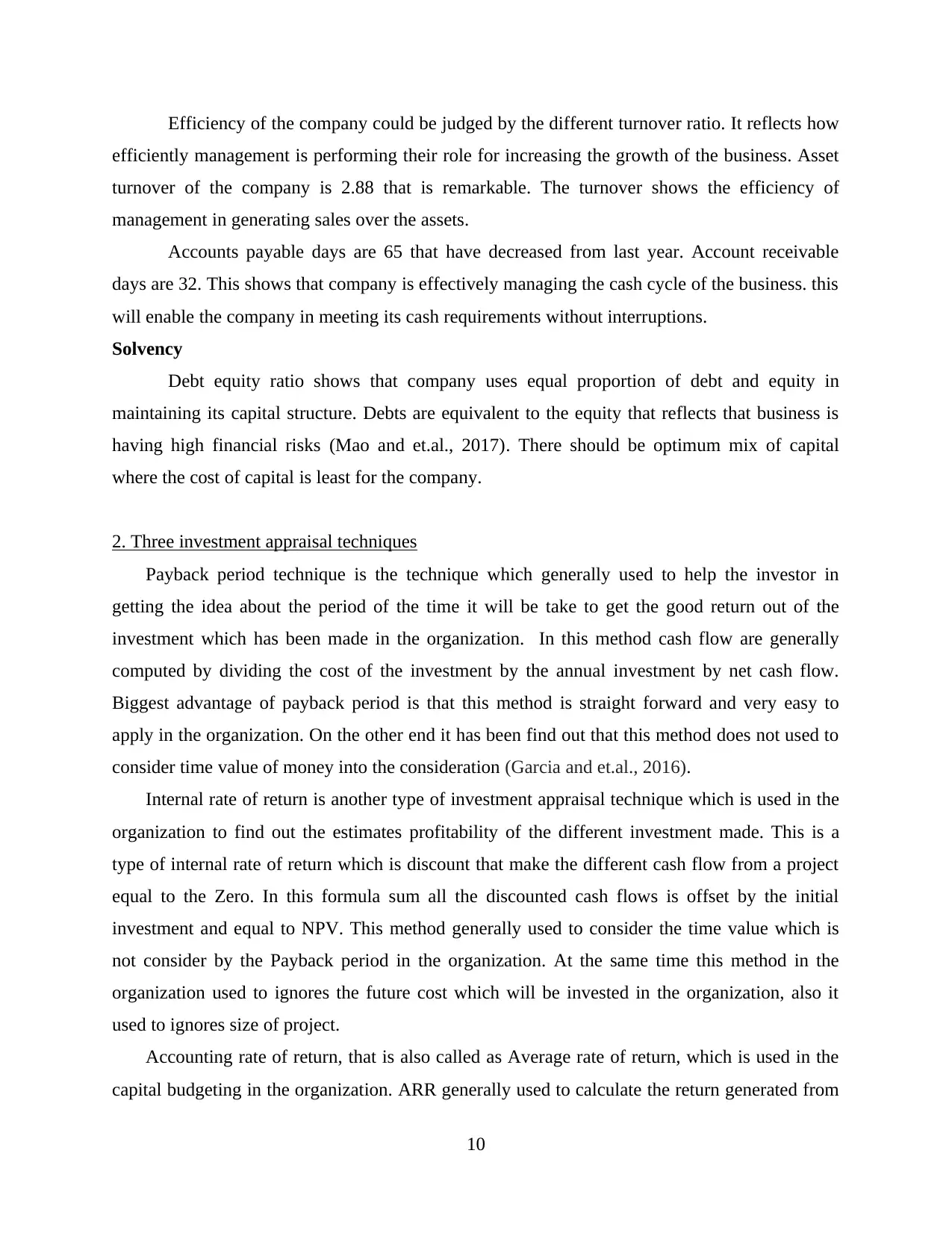
Efficiency of the company could be judged by the different turnover ratio. It reflects how
efficiently management is performing their role for increasing the growth of the business. Asset
turnover of the company is 2.88 that is remarkable. The turnover shows the efficiency of
management in generating sales over the assets.
Accounts payable days are 65 that have decreased from last year. Account receivable
days are 32. This shows that company is effectively managing the cash cycle of the business. this
will enable the company in meeting its cash requirements without interruptions.
Solvency
Debt equity ratio shows that company uses equal proportion of debt and equity in
maintaining its capital structure. Debts are equivalent to the equity that reflects that business is
having high financial risks (Mao and et.al., 2017). There should be optimum mix of capital
where the cost of capital is least for the company.
2. Three investment appraisal techniques
Payback period technique is the technique which generally used to help the investor in
getting the idea about the period of the time it will be take to get the good return out of the
investment which has been made in the organization. In this method cash flow are generally
computed by dividing the cost of the investment by the annual investment by net cash flow.
Biggest advantage of payback period is that this method is straight forward and very easy to
apply in the organization. On the other end it has been find out that this method does not used to
consider time value of money into the consideration (Garcia and et.al., 2016).
Internal rate of return is another type of investment appraisal technique which is used in the
organization to find out the estimates profitability of the different investment made. This is a
type of internal rate of return which is discount that make the different cash flow from a project
equal to the Zero. In this formula sum all the discounted cash flows is offset by the initial
investment and equal to NPV. This method generally used to consider the time value which is
not consider by the Payback period in the organization. At the same time this method in the
organization used to ignores the future cost which will be invested in the organization, also it
used to ignores size of project.
Accounting rate of return, that is also called as Average rate of return, which is used in the
capital budgeting in the organization. ARR generally used to calculate the return generated from
10
efficiently management is performing their role for increasing the growth of the business. Asset
turnover of the company is 2.88 that is remarkable. The turnover shows the efficiency of
management in generating sales over the assets.
Accounts payable days are 65 that have decreased from last year. Account receivable
days are 32. This shows that company is effectively managing the cash cycle of the business. this
will enable the company in meeting its cash requirements without interruptions.
Solvency
Debt equity ratio shows that company uses equal proportion of debt and equity in
maintaining its capital structure. Debts are equivalent to the equity that reflects that business is
having high financial risks (Mao and et.al., 2017). There should be optimum mix of capital
where the cost of capital is least for the company.
2. Three investment appraisal techniques
Payback period technique is the technique which generally used to help the investor in
getting the idea about the period of the time it will be take to get the good return out of the
investment which has been made in the organization. In this method cash flow are generally
computed by dividing the cost of the investment by the annual investment by net cash flow.
Biggest advantage of payback period is that this method is straight forward and very easy to
apply in the organization. On the other end it has been find out that this method does not used to
consider time value of money into the consideration (Garcia and et.al., 2016).
Internal rate of return is another type of investment appraisal technique which is used in the
organization to find out the estimates profitability of the different investment made. This is a
type of internal rate of return which is discount that make the different cash flow from a project
equal to the Zero. In this formula sum all the discounted cash flows is offset by the initial
investment and equal to NPV. This method generally used to consider the time value which is
not consider by the Payback period in the organization. At the same time this method in the
organization used to ignores the future cost which will be invested in the organization, also it
used to ignores size of project.
Accounting rate of return, that is also called as Average rate of return, which is used in the
capital budgeting in the organization. ARR generally used to calculate the return generated from
10
⊘ This is a preview!⊘
Do you want full access?
Subscribe today to unlock all pages.

Trusted by 1+ million students worldwide
1 out of 17
Related Documents
Your All-in-One AI-Powered Toolkit for Academic Success.
+13062052269
info@desklib.com
Available 24*7 on WhatsApp / Email
![[object Object]](/_next/static/media/star-bottom.7253800d.svg)
Unlock your academic potential
Copyright © 2020–2025 A2Z Services. All Rights Reserved. Developed and managed by ZUCOL.





